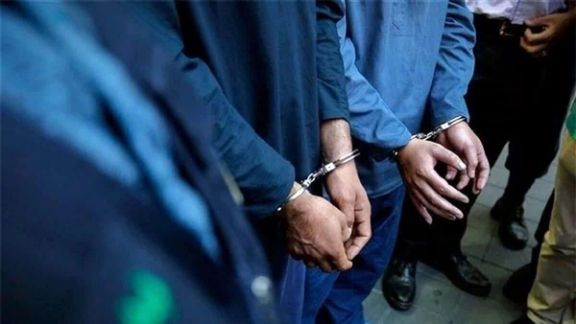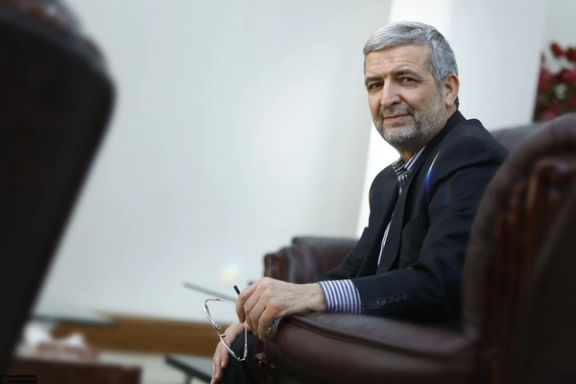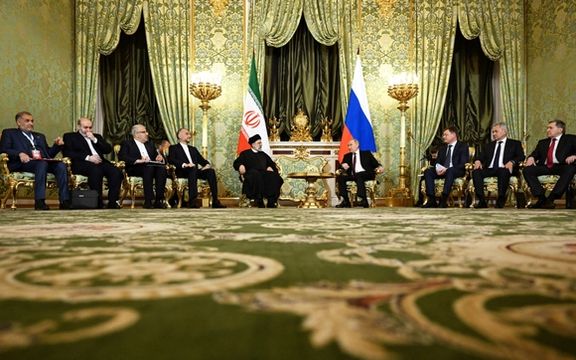Iran Says Several Azerbaijanis Arrested For Alleged Sabotage Plans

Iranian security forces have arrested several people who entered Iran from the Republic of Azerbaijan, alleging that they planned to perform sabotage operations within the country.

Iranian security forces have arrested several people who entered Iran from the Republic of Azerbaijan, alleging that they planned to perform sabotage operations within the country.
IRGC-linked Tasnim News Agency reported Wednesday that “Several foreign spies and terrorists, under central guidance, entered Iran from the Republic of Azerbaijan with the intention of carrying out sabotage operations within the country, but they were identified and arrested before taking action.”
Iran's intelligence agencies frequently announces busting spy networks and detaining saboteurs within Iran borders, although subsequent information about trials and convictions is scarce. Such incidents have been on the rise in recent years, with clandestine attacks targeting nuclear facilities, and military installations. Iran’s intelligence apparatus lost significant face after sabotage attacks on its Natanz nuclear facility in 2020 and 2021.
While the Iranian government often attributes such incidents to Israel, Israeli officials have never officially claimed responsibility.
In late January, the Iranian regime executed four Kurdish political prisoners on charges of plotting to bomb a defense facility. Human rights groups have criticized the executions, citing allegations of confessions obtained under torture and unfair trials.

Football, or soccer, stands as Iran's most beloved sport, captivating millions from local alleyways to international stadiums, and it has taken sharp political dimensions.
Amidst growing tensions between the government and the populace, football has morphed into a battleground for ideological conflict. At the heart of the dispute lies the question: Is the team representing Iran truly the national team, or merely a tool of the regime? On both sides of the debate, myriad factions offer diverse perspectives. This strife is absent in less prominent sports like water polo, badminton, and skiing, where neither the government nor the people invest significant interest, rendering them immune to political exploitation.
The convergence of the "Women, Life, Freedom" movement with the 2022 World Cup in Qatar catapulted this struggle onto the streets, prompting some to rally behind opposing teams—some even cheered for the American team after Iran's defeat in their match. In this clash, several youths fell victim to the regime's brutality, like Mehran Sammmak in Bandar Anzali. Although the Asian Games in 2024 saw less street activism, the conflict rages on through social media and traditional channels.

Arguments from both camps:
“Regime’s Squad”
Those branding the existing team as the regime's squad cite several factors. Foremost is the regime's penchant for anti-meritocracy and ideological vetting, even in sports. Under the Islamist regime's totalitarian grip, no sphere of life remains immune to government intervention. The regime extends special privileges to footballers, including duty-free luxury imports and generous state-backed salaries. These perks serve as ideological carrots, motivating players to echo regime rhetoric, as exemplified by Qala Noui's post-match gratitude to divine intervention after a victory.
Furthermore, the regime's propaganda machine operates in overdrive within football, from orchestrated spectator attendance to grandiose declarations by top officials upon victory. The regime intertwines football successes with national achievements, glorifying players' meetings with high-ranking officials and showering them with accolades. The regime's obsession with celebrity status extends to football, positioning players as national icons.
Additionally, footballers face constant surveillance, with every word and action scrutinized. Their families are not spared from intimidation, reinforcing the regime's grip over players' public personas. Despite expectations of solidarity with the populace, footballers remain tethered to the regime's narrative, perpetuating its agenda regardless of match outcomes.
People expect a national team to be with them in their joys and sorrows, something the current football team fails to do in the view of many Iranians, who return the attitude by turning their backs to them.

National Team
Conversely, proponents of the team as the national squad offer a contrasting narrative. They argue that many players are European-based professionals selected on merit rather than political allegiance. While the regime may exploit players for propaganda, it does not define their allegiance. Some players have demonstrated dissent, supporting past protests like the 2009 Green Movement, indicating their independence from regime narratives.
However, the issue is not about a few players voicing solidarity with protesters, but the attitude of the team as a whole.
Victories by the team elicit national jubilation, transcending regime affiliations. Despite forced interactions with regime figures, players harbor no illusions about their roles as symbols of national pride. Their mandate is not to champion dissent but to represent the nation on the global stage.
The absence of comprehensive surveys complicates attributing public sentiment, or the exact attitudes of team members. Nonetheless, verifiable accounts underscore the chasm between regime control and public sentiment, demonstrating that both sentiments exist among the populace.

The bodies of five militants from the Iran-backed Fatemiyoun division were buried on Wednesday in the northeastern city of Mashhad.
Identified by IRNA as Ali Hosseini (son of Amir), Ali Hosseini (son of Mohammad Hossein), Ali Hosseini (son of Ebrahim), Hamzeh Alavi, and Mohammad Ali Akbari, the militias were killed in the recent US attacks.
Reports from the Telegram channel Defenders of the Shrine indicated on Monday that four members of the Fatemiyoun, including Ali Hosseini, Hamzeh Alavi, Mohammad Ali Akbari, and Mohammad Reza Sadat Alavi, died in a recent US attack on Syria. The moniker Defender of the Shrine is associated with forces dispatched to Syria in support of President Bashar al-Assad's regime.
Ali Hosseini was a commander within the Fatemiyoun Brigade in eastern Syria. Images circulating onlineshow him alongside Qasem Soleimani, the former commander of the IRGC’s Quds Force who was killed by the US in 2020.
The Sunday US military's strike on Iran-affiliated militias in eastern Syria occurred as the US has increased strikes against Iran-backed forces in retaliation to the killing of American soldiers in Jordan. Last week, three US service members lost their lives in drone attacks perpetrated by Iran-backed groups in northeastern Jordan, the first American fatalities since Iran’s proxies has come out in allegiance with Hamas in Gaza.
The Fatemiyoun Brigade, operating under the auspices of the Quds Force of the Revolutionary Guards, comprises Afghan immigrants in Iran and has been actively deployed in Syria in recent years. Criticism of Iran's recruitment tactics has been pervasive, with observers and human rights activists condemning the exploitation of Afghan refugees' dire circumstances to engage in regional conflicts, including the ongoing conflict in Syria.

Ebrahim Raisi's special envoy for Afghanistan has claimed that Iran has fighters ready to support the war in Gaza amid its regional proxy war against Israel and the US.
In an interview with the Afkar Network, Hassan Kazemi-Qomi said, "Although Afghanistan is farther from Gaza, if necessary, more than one brigade from this country will go to support Gaza."
Iran-backed Hamas invaded Israel on October 7 in what was the most deadly single day for Jews since the Holocaust. Since then, Israel's relentless retaliation and the US support for its right to defend itself has sparked a regional proxy war. Iran's militias in Syria, Lebanon, Iraq and Yemen have joined the fight in support of Hamas in Gaza.
Kazemi-Qomi's statement comes after the Iranian regime launched a multi-platform campaign to recruit fighters for the Hamas conflict against Israel. Despite Iranians branding it as a propaganda stunt, the regime initiated the campaign through various outlets including websites affiliated with the Revolutionary Guards and the state broadcaster.
A chyron message urging viewers to sign up and declare their readiness to be dispatched to Palestine aired during broadcasts. Additionally, Iranians received SMS messages prompting them to express their willingness to participate. The regime also established a website named "al-Aqsa Storm," mirroring Hamas's codename for its offensive into Israel, which claimed numerous civilian and military casualties, alongside the taking of hostages.
Iran's proxies are mostly made up of fighters from Shia Muslim–majority countries such as Iraq and Lebanon but Shia groups in Sunni-majority Afghanistan, its border neighbor, the

Iran's Foreign Investment Organization CEO claims the country has attracted $10.6 billion in “foreign investment” since President Ebrahim Raisi assumed office in August 2021.
Ali Fekri stated that almost half of this figure is related to the oil and gas sector, with Russia leading other foreign investors with $2.7 billion in funds.
He went on to say that the attracted investment value during the last fiscal year, from March 2022 to 2023, was $4.2 billion. However, according to the United Nations Conference on Trade and Development (UNCTAD), Iran attracted only $1.5 billion in foreign direct investment in 2022.
Fekri's claim about $10.6 billion in "foreign investment" came after he recently cited the figure of $9.2 billion in an interview with the semi-official Tasnim news agency on November 23, 2023.

He explained at the time that the figure doesn’t mean $9.2 billion foreign cash funds flowed into the country; rather, it is the amount of "approved investment projects and contracts by foreigners" since the start of the Raisi administration. In simpler terms, what he refers to as "attracted foreign investment" is indeed the value of contracts with foreigners.
Fekri also mentioned that during the last fiscal year ending March 21, 2023, Iran attracted $4.2 billion in foreign investment, about 170% more than the previous year. However, UNCTAD's statistics do not indicate any significant investment inflow to Iran during 2022 compared to 2021.
He did not elaborate on why his claimed "attracted investment value" increased from $9.2 billion to $10.6 billion since November 2023, especially considering that Iran has not announced any new contracts with foreigners in the last three months. He named Russia, China, UAE, and Turkey as the biggest "investors" in Iran since August 2021.
Russian 'Investment'
Regarding Russian "investment," his claim about attracting $2.7 billion in investment came while Russian companies have only sealed contracts to drill wells in seven Iranian oil fields. This represents service exports rather than investment contracts. For example, one of these companies, Russian ZN Vostok Ltd., is obligated to drill 20 wells and install 22 pumps in the Cheshme Khosh oil field. Its CEO, Azamat Faridovich Ismagilov, stated that the total value of contracts with Iran is $500 million, including $170 million for the Cheshme Khosh field.
It’s CEO, Azamat Faridovich Ismagilov said on February 6 that ZN Vostok’s total value of contracts with Iran is $500 million, including $170 million on Cheshme Khosh field. “We have three drilling rigs in Iran and have a plan to add another one for drilling 6 new wells”.
ZN Vostok signed the contract with Iran in April 2022 to develop the above-mentioned field. It has increased the field’s production by 29% to 62,000 barrels per day so far by drilling 14 wells.
Iran has a history of exaggerating cooperation levels with its "anti-western" partners like Russia and China, especially when good economic news becomes scarce and the national currency, rial, nosedives. Since the beginning of January the rial has lost more than 10 percent of its value against the US dollar and other major currencies.
For instance, while Iran proudly announced the signing of the "largest oil and gas agreements in the country's history worth $40 billion” with Russian Gazprom in 2022, Morteza Behruzifar, an energy expert in Tehran told the ILNA news website that even before the Western sanctions on Russia, it had not invested a penny in Iran.
Like most Russian companies, Gazprom is hardly in a position to invest in another country. Its revenues plunged to $3.1 billion in the first half of 2023, from $16.5 billion in 2022.
Although Gazprom plans to invest $17.5 billion in 2024, 20 percent less than 2023, none of its mentioned investment are related to Iran.

Mehrad Ebad, a member of the Iranian Chamber of Commerce, has voiced concerns over the volatility of Iran's national currency.
He stated on Wednesday that, "Nowhere else in the world does the national currency's value drop by 20% overnight."
In the address, he added, “Economic stability is one of the most crucial needs for businesses, enabling their owners to plan based on this stability. Unfortunately, in recent decades, stability has been lacking in the Iranian economy, and domestic and international events with direct and indirect impacts on Iran's economy have influenced the exchange rate.”
The Iranian rial's recent nosedive against the US dollar has exacerbated the concerns. Last week, the rial plummeted to 575,000 against the dollar amidst escalating regional tensions and uncertainties surrounding the US presidential election, particularly regarding the potential re-election of Donald Trump.
Although the rial has regained some of its value in the past few days, reaching 557,000 against the dollar, the overall trend remains worrying. Since 2018, the currency has depreciated 13-fold, triggered by the US withdrawal from the JCPOA nuclear deal and subsequent sanctions on Iran's oil exports and international banking.
With an annual inflation rate exceeding 50 percent, the diminishing value of the rial is expected to exacerbate inflationary pressures in the coming months. The economic instability is compounded by low monthly wages for workers, averaging less than $200, leading to widespread discontent and protests across various sectors, including oil and gas production platforms and refineries.